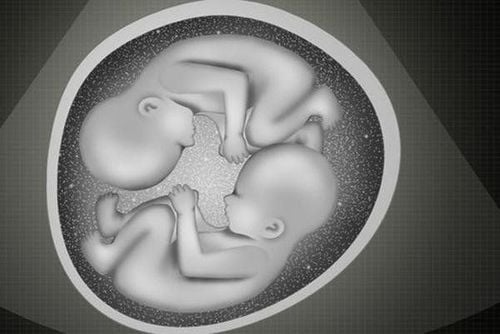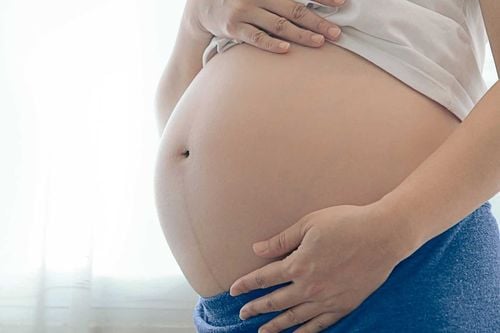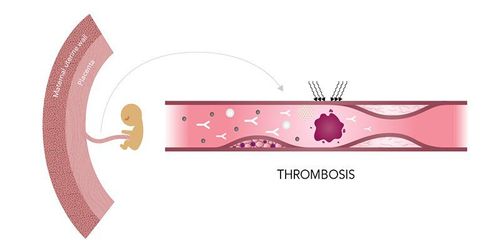This is an automatically translated article.
Placenta is an important organ that connects the fetus to the mother's uterus through the umbilical cord, helping the fetus to develop in the uterus. An abnormal phenomenon of the placenta's attachment position can affect the health of the baby and even be dangerous for both mother and baby. So what's behind each other?
1. What is the posterior placenta?
Placenta, also known as placenta, is an important part connecting the fetus to the mother's uterine wall through the umbilical cord, this is an important organ that helps the fetus develop in the womb. maternal supply by transporting oxygen and essential nutrients. In addition, the placenta also has a role in removing waste from the blood of the fetus, this is like a link between mother and baby. The placenta is round and red, can weigh up to 0.9kg and is formed from the moment the embryo attaches to the wall of the uterus. A few days later, the placenta attaches to the endometrium to carry on feeding the baby. The placenta will go through many changes from conception to birth.
What is the rear of the placenta? The placenta can develop anywhere where a fertilized egg attaches to the wall of the uterus. Posterior placenta is a condition in which the placenta attaches to the back wall of the uterus and is closest to the spine. This is a completely normal and very good position, allowing pregnant women to feel the baby's movements earlier and more clearly. However, pregnant women should not be subjective and need to go to antenatal care periodically to know the position of the placenta and take timely intervention measures if the placenta moves abnormally.
2. Types of status clinging to the back
The posterior placenta is divided into two main groups:
The posterior placenta is group 1 when the superior border of the placenta crosses the fundus of the uterus or is at the fundus. Group 2 posterior placenta, also known as low posterior placenta, when the superior border of the placenta is above 1/2 of the uterine body or at body level. The position of the placenta attached to the back of group 2 is lower than that of group 1, although these are all normal positions, they still need to be monitored, because as the fetus grows, the placenta will also increase in size and area. Vegetables will change and spread in many different directions, especially the low-lying vegetable cake on the back. Some signs that pregnant women can recognize low back in the last 3 months of pregnancy are sudden unexplained bleeding without abdominal pain, bright red blood and when coming out. The outside will coagulate into a lump. Bleeding can be repeated many times and this is also a warning sign of abnormality in pregnancy.
Some complications of low back placenta are:
For pregnant women:
Anemia during pregnancy: due to easy bleeding during pregnancy, the risk of anemia is often increased. If a pregnant woman has severe anemia, it increases the risk of fetal growth retardation and premature birth. Bleeding at birth: During labor, the placenta can detach prematurely, causing the mother to lose a lot of blood, even shock due to excessive blood loss. In case the placenta attaches close to the cervix, after delivery, the placenta separates, causing the uterus to bleed a lot, possibly having to remove the uterus if the bleeding is heavy. Increases the risk of cesarean section: Pregnant women with low back placenta will often be assigned to have a cesarean section and be hospitalized early for follow-up to minimize dangerous obstetric complications. For the fetus:
The fetus is at risk of malnutrition and growth retardation due to maternal anemia. Severe cases can lead to fetal distress. Abnormal fetal position: Because the placenta is located near the cervix, it makes it difficult for the fetus to turn to the right, which can easily lead to abnormal fetal positions such as breech or transverse. Premature birth: In case a pregnant woman has heavy vaginal bleeding, to ensure safety, the doctor may appoint an early cesarean section even though the pregnancy is not yet full term. When born prematurely, babies will be underweight and prone to many health problems such as respiratory failure...
3. What should pregnant women do if the placenta clings to the back?
Currently, there is no method that can treat the condition of low-attached placenta. All measures are directed to the role of minimizing the possible risks to mother and baby. When diagnosed with low placenta, pregnant women need to go to a hospital with a reputable obstetrician for regular check-ups and ultrasounds, and absolutely follow the doctor's instructions. In addition, mothers should note more:
Take the time to rest absolutely, stand and sit only when absolutely necessary, do not worry too much. Limit exercise a lot, limit riding motorbikes, traveling long distances, bumpy roads. Absolutely avoid intercourse. Absolutely do not affect the abdomen to avoid stimulation of the uterus, causing bleeding. Eat nutritious food, eat foods that are easy to digest to avoid constipation and bloating. In short, the placenta is attached to the back is a very normal condition, but in some cases, the placenta is quite dangerous to the health of both mother and baby. However, if detected early and have a reasonable lifestyle, it is not a worrisome situation. Therefore, to ensure safety during pregnancy, pregnant women need to visit the doctor on schedule and fully as prescribed.
To protect mother and baby's health comprehensively, Vinmec International General Hospital now has a package maternity service, with a team of highly qualified doctors, ultrasound machine system, and medical equipment. Modern equipment will promptly recognize abnormalities during pregnancy, help monitor the health of mother and baby right from the beginning of pregnancy, early detect and timely intervene health problems.
Please dial HOTLINE for more information or register for an appointment HERE. Download MyVinmec app to make appointments faster and to manage your bookings easily.













